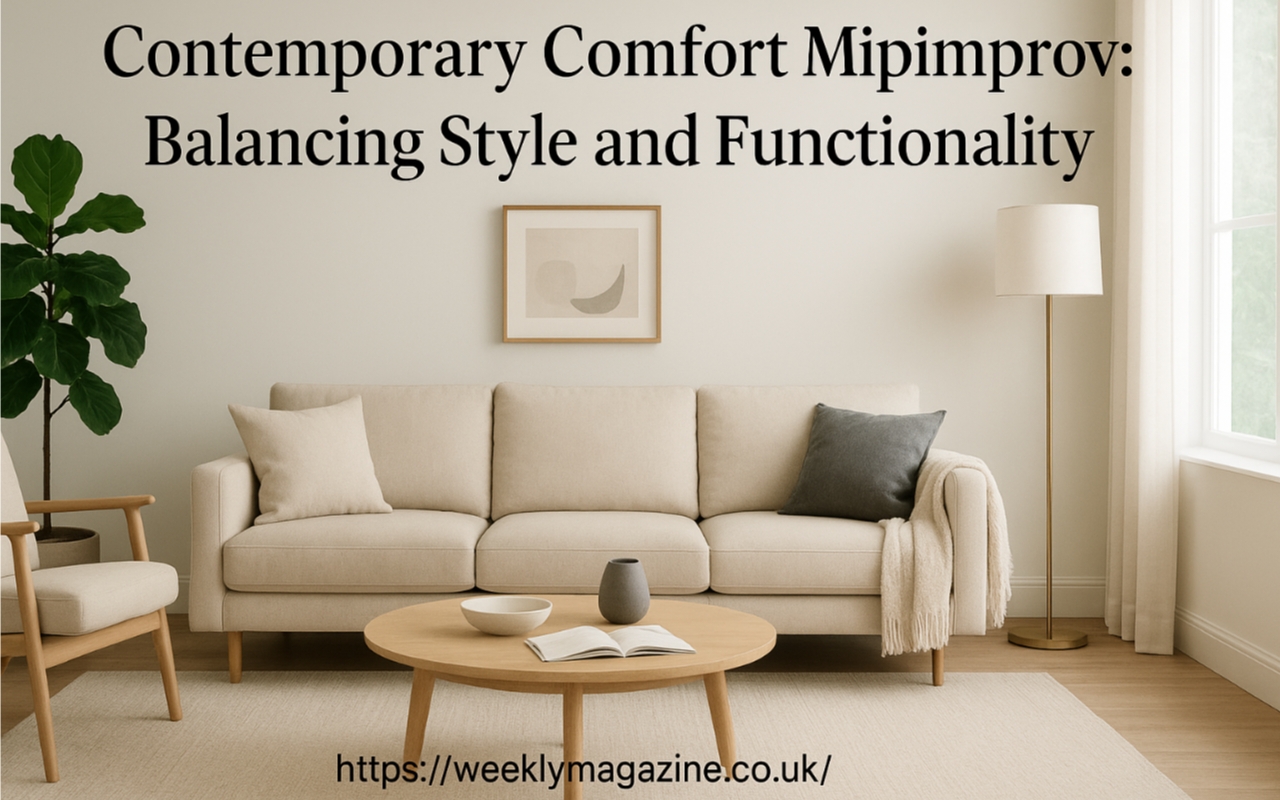Table of Contents
ToggleIntroduction to Contemporary Comfort Mipimprov
In today’s world of design, architecture, and lifestyle trends, the phrase Contemporary Comfort Mipimprov has emerged as a way of describing a philosophy that goes beyond aesthetics and functionality. It embodies a modern balance where style meets usability, and where comfort is just as important as innovation. While traditional approaches to design often focused on either elegance or practicality, Contemporary Comfort Mipimprov combines both to create spaces, products, and experiences that feel complete. Whether it’s in home design, office spaces, hospitality, or even personal lifestyle choices, this concept has become a leading factor in how individuals and industries define modern living. Understanding what Contemporary Comfort Mipimprov stands for can help homeowners, professionals, and businesses reimagine the way they approach comfort without sacrificing modern appeal.
The Origins and Meaning of Contemporary Comfort Mipimprov
The concept of Contemporary Comfort Mipimprov is rooted in the evolving needs of people who want more than just visually pleasing spaces. The word “contemporary” reflects modern styles, sleek finishes, and current trends, while “comfort” highlights warmth, relaxation, and user-centric design. The “Mipimprov” part of the term represents improvement and adaptation, signifying a movement toward better integration of form and function. Together, these elements represent a design and lifestyle framework that aims to improve not just how a place looks but how it feels and operates in daily life. As more individuals embrace flexible lifestyles, remote work, and sustainability-driven living, this philosophy has expanded across multiple industries, reshaping design standards around the world.
Why Style Alone Is Not Enough
In the past, many people equated style with luxury. Glossy finishes, sharp lines, and trend-forward designs were enough to impress. However, the problem with style-driven approaches is that they often ignored long-term usability. For example, a stunning modern sofa that looks good in a showroom may be uncomfortable to sit on for extended periods. Similarly, homes with overly minimal designs may look pristine but fail to accommodate real-life needs, such as storage, coziness, and adaptability. Contemporary Comfort Mipimprov addresses these shortcomings by ensuring that style is balanced with human-centered comfort. A well-designed space should be livable, practical, and flexible while still being visually engaging.
Functionality as the Heart of Modern Living
Functionality has become the cornerstone of Contemporary Comfort Mipimprov. In a world where living spaces are shrinking due to urbanization, and lifestyles are constantly changing, homes and workplaces need to adapt. Functional design includes modular furniture, multipurpose spaces, and user-friendly layouts that optimize both comfort and efficiency. For instance, a compact apartment may feature a fold-out bed, a convertible desk, and hidden storage to maximize space. Similarly, an office designed with functionality in mind will incorporate ergonomic furniture, adjustable lighting, and acoustic elements that enhance productivity. Functionality ensures that modern spaces don’t just look good—they support the diverse needs of daily life.
The Role of Technology in Contemporary Comfort Mipimprov
Technology plays a huge role in shaping how style and comfort intersect in today’s environments. Smart home devices, automated lighting, voice-controlled assistants, and energy-efficient systems are all part of what makes spaces more livable and functional. However, the challenge lies in integrating technology without compromising on aesthetics. A home filled with visible wires and bulky gadgets can quickly lose its stylish appeal. The solution offered by Contemporary Comfort Mipimprov is seamless integration—embedding technology into design elements so that it enhances both appearance and comfort. For example, smart thermostats that blend into the wall, or wireless charging stations built into furniture, showcase how design and technology can coexist harmoniously.
Sustainability and Eco-Friendly Comfort
Another key dimension of Contemporary Comfort Mipimprov is sustainability. Modern consumers are increasingly aware of their environmental impact, and they expect design solutions that are not only stylish but also eco-conscious. Sustainable design emphasizes natural materials, energy-efficient systems, and long-lasting products that reduce waste. Incorporating recycled furniture, using eco-friendly paints, and maximizing natural light are just some of the ways spaces achieve this balance. Comfort here does not just refer to physical ease but also the mental peace that comes with knowing your lifestyle choices are better for the planet. This eco-conscious mindset is now integral to what makes a space contemporary and comforting.
Contemporary Comfort in Residential Design
Residential spaces are perhaps the most visible examples of how Contemporary Comfort Mipimprov manifests in daily life. Homeowners today are looking for environments that are stylish yet livable. Open floor plans, natural textures, calming color palettes, and adaptable furniture are becoming the standard. Kitchens, for example, are no longer just for cooking but also for socializing and working, which requires designs that merge functionality with comfort. Living rooms are evolving into flexible hubs that support entertainment, relaxation, and sometimes even work. Bedrooms are being designed as sanctuaries that combine aesthetic minimalism with cozy warmth. In each of these areas, style and comfort work together to create homes that feel modern yet welcoming.
Contemporary Comfort in Workspaces and Offices
The workplace has undergone a massive transformation in recent years, with remote work and hybrid models changing how we define productivity. Offices are no longer about rigid desks and cubicles; instead, they are about creating environments that foster collaboration, creativity, and well-being. Contemporary Comfort Mipimprov in office design focuses on ergonomic seating, natural lighting, biophilic design (bringing nature indoors), and flexible work zones. These elements not only improve productivity but also ensure employees feel comfortable, valued, and motivated. Stylish meeting pods, relaxation corners, and multipurpose breakout areas are excellent examples of how this philosophy has reshaped modern offices.
Hospitality and the Guest Experience
Hotels, restaurants, and resorts are also embracing Contemporary Comfort Mipimprov to enhance customer satisfaction. Guests expect spaces that are not only visually impressive but also deeply comfortable. Hotels, for instance, are investing in smart room controls, luxurious yet functional furniture, and soothing color schemes that appeal to both style and relaxation. Restaurants are moving beyond trendy aesthetics to prioritize seating comfort, acoustics, and atmosphere that encourages longer stays. The hospitality industry understands that true luxury is not just about looking good but about how the guest feels during their experience—making this philosophy central to success.
Lifestyle Choices Beyond Design
Interestingly, the principles of Contemporary Comfort Mipimprov go beyond interior design and architecture. They influence lifestyle choices in fashion, wellness, and even technology use. In fashion, for instance, there’s a growing emphasis on clothing that is stylish yet comfortable—athleisure being a prime example. In wellness, spa-like experiences are being incorporated into everyday routines, with people choosing products and activities that bring both relaxation and sophistication. Even in technology, user interfaces and device designs are evolving to be sleek yet intuitive, proving that the balance of style and comfort applies across industries.
The Future of Contemporary Comfort Mipimprov
As society continues to evolve, so too will the interpretation of Contemporary Comfort Mipimprov. Future trends point toward even greater personalization, where design adapts to individual lifestyles and preferences. Artificial intelligence could tailor lighting, temperature, and furniture adjustments based on user habits. Sustainability will also play an increasingly central role, with innovations in renewable materials and energy-efficient living becoming standard. What will remain constant, however, is the philosophy that comfort and style are not opposites but partners. The homes, offices, and lifestyles of tomorrow will be shaped by this principle, ensuring that design continues to serve both human needs and aesthetic aspirations.
Conclusion
Contemporary Comfort Mipimprov is more than just a design trend—it is a comprehensive philosophy that recognizes the importance of balancing style and functionality. From residential spaces to offices, hospitality to lifestyle choices, this approach ensures that people can live in environments that are not only beautiful but also deeply practical and satisfying. As technology, sustainability, and personalization continue to redefine modern living, this balance will remain at the heart of innovation. For anyone seeking to create spaces or adopt lifestyles that reflect both modern appeal and everyday usability, embracing Contemporary Comfort Mipimprov is the key to truly harmonious living.

